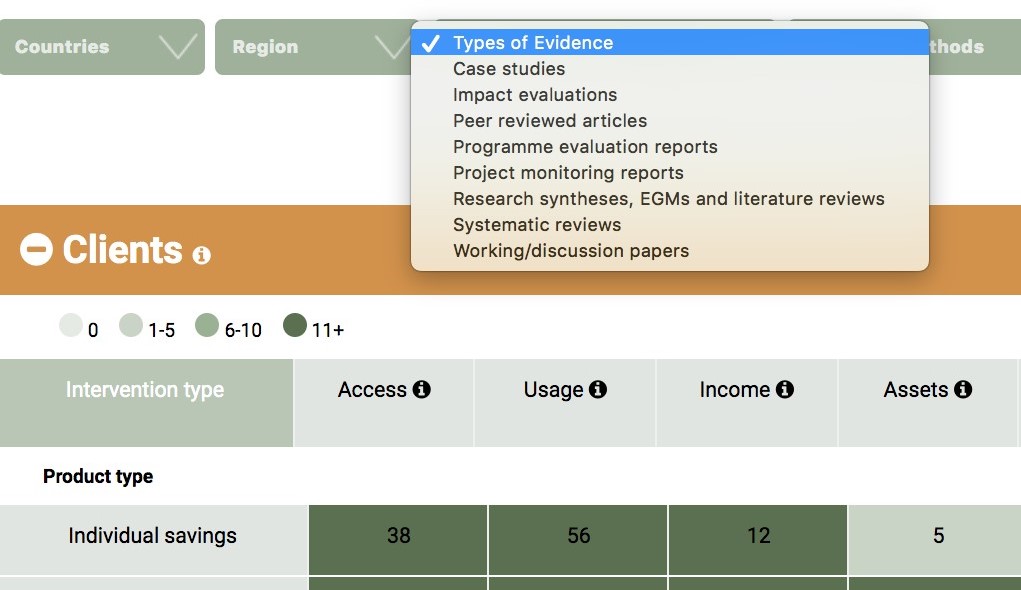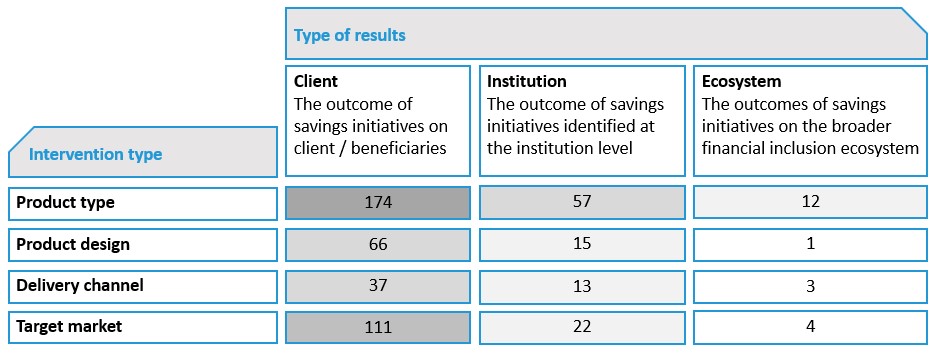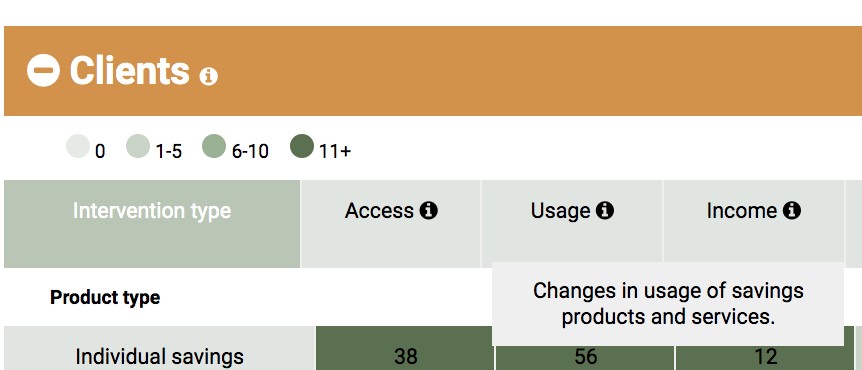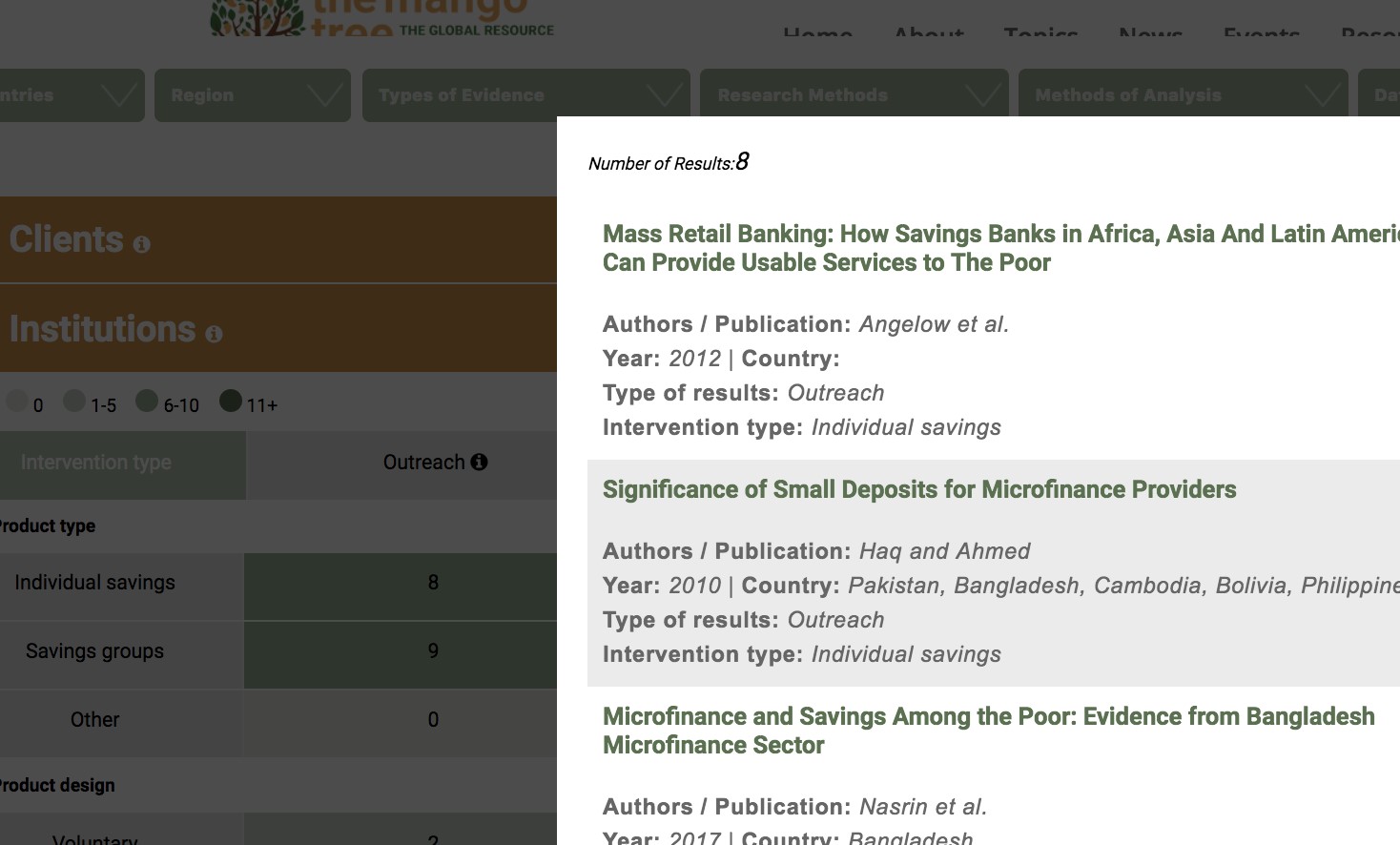Aug 20, 2019 | by Diana Dezso, Itad

The Savings Evidence Map lives on the Mango Tree and consolidates evidence on a broad range of savings initiatives.
The Savings Evidence Map was launched in 2018 as part of the Savings Learning Lab activities. The first annual update just added 37 new resources on evidence, bringing the total number of studies included in the map to 299. The overall distribution and characteristics of the evidence have not significantly changed since the first mapping. Studies documenting client level results continue to dominate and evidence at the ecosystem level is sparse. This leads us to conclude that research continues to focus on the related topics and that the evidence gaps remain wide and unfilled.
Nevertheless, a thorough consultation process with experts in the field and our partners, we can see that people are using it to consult the available evidence.
It is a one-stop-shop for relevant and reliable evidence on a broad range of savings initiatives, including ones related to savings groups, individual savings, formal and informal savings.
If you Google the impact of savings on low-income women, you get over 100 million search results.

Well, fear not! If you are interested in the most recent and reliable evidence on savings-focused financial inclusion initiatives, we’ve done all the searching and sifting for you. The Savings Evidence Map provides consolidated access to relevant evidence, enables users to navigate the existing evidence, as well as identify gaps and additional opportunities for research and programming. The evidence included in the map builds on four learning questions of the Savings Learning Lab:
Furthermore, the map organizes the evidence into a matrix structure – by type of results (see figure 1) grouped into client, institutions and ecosystem-level results, and by the type of savings intervention documented in the evidence, such as interventions focused on product type, product design, product distribution channels and target markets. The figures in each cell indicate the number of studies in the respective category. It is important to note that several studies document multiple types of results so if users are tempted to do the math the total will add up to more than 299.

Figure 1


Screenshots from the Savings Evidence Map
The map is intended for practitioners looking for evidence of what works (and what doesn’t) to help inform decisions on savings programming and policies. It is intended for donors and investors interested in making evidence-based, strategic investments in this area, and for researchers interested in filling the evidence gaps.
The map is designed to be user-friendly and was informed by an extensive consultation process, indicating that there existed a demand for evidence consolidation among practitioners involved in savings programming. There was also interest for the evidence to be categorized by type of results achieved, type of savings intervention, research methods and level of results achieved.
We invite users to explore the evidence included in the map and access the studies they are interested to learn more about by clicking, hovering, sorting, and generally poking around the map.
In addition, the consultation process also uncovered a demand for deep-dives and synthesis of evidence. In response, we’ve taken a sub-section of the map that looks at outcomes for savings for youth and we invite others to dig deeper into other areas and let us know what you find.
The map is updated annually with newly available evidence that meets a set of inclusion criteria. The next update is scheduled in early 2020. In the meantime, please let us know if you have any questions or know of studies that you think should be added to the map.
The online map is hosted on the Mango Tree, an initiative of the SEEP Network.
A synthesis report and a summary report are also available for download.
Diana is team leader of the Mastercard Foundation Savings Learning Lab. In this role, she provides organizational and technical leadership on activities aimed to support learning among the learning partners and others in the sector through the generation, synthesis, curation and dissemination of knowledge.
Diana specializes in learning and organizational development, capacity assessment, program implementation and evaluation, and new business development. She works with global alliances and learning networks on knowledge management, engagement and expansion strategies. She has undertaken global research on strategic risks and opportunities facing MFIs in the developing world. She has worked in senior leadership positions of international organizations in both Washington and the field, including The SEEP Network and ACCION USA.
Diana has an MPA from New York University and is fluent in Romanian, proficient in Spanish, and speaks basic French.
Categories: Savings Groups English Savings Groups Blog Blog WebinarsBlogs

1621 North Kent Street, Ste 900,
Arlington, VA, 22209
P 202.534.1400
F 703.276.1433
Website Photos: © mari matsuri
